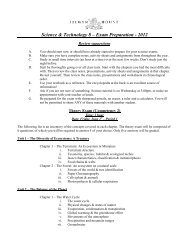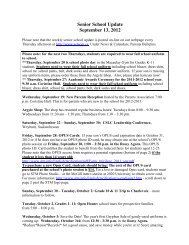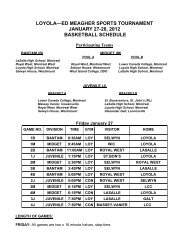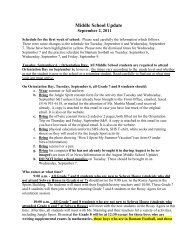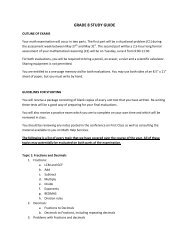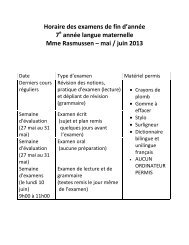ConflictAristotle, our first and most influential theorist on plot, tells us that all good plots begin withconflict: the protagonist (the chief character) desires to achieve a goal, but circumstance(sometimes in the form of an opposing character, the antagonist) works against the achievementof that goal. The plot, says Aristotle, ought to work like the tying and the untying of a knot (thelast part of a plot is called the denouement, which is French for “untying”). As the protagonistworks against odds to gain his desire, events become tied into complications; but the knot intowhich the complications have become tied loosens after the protagonist faces, at the climax, thegreatest of the obstacles that conflict with his desires. Conflict, then, is properly considered theorigin of plot, and the working through of conflict towards resolution constitutes the very substanceof the plot.First identify the major conflicts that form the plot. Decide for yourself what the protagonist’sgoal is; the three or four most important forces working against the achievement of that goal willeach produce a sub-plot you ought to deal with in a separate section of the portion of your essaydevoted to action. It is a good idea to put the conflicts in climactic order, which entails puttingthe least important conflict first and working from there up to the most important. Such an orderprovides automatically the material for a concluding summary at the end of the analysis you willmake of action.NOTE: Identifying and classifying conflicts is a preliminary organizational step in writing theaction section of your plot analysis; you ought not to write separate paragraphs about conflict.It is sometimes helpful to classify conflict as internal or external. Internal conflict pits a managainst himself; within him, two or more forces or desires oppose one another. External conflict,on the other hand, pits a man against some force outside himself. The most frequent externalconflict opposes a man with another man, but quite often an external conflict pits a man againstsome natural force (storm, mountain, sea, shark). In addition to such physical forces, a man maystruggle externally against a non-human force such as society, fate, or the gods; we call such aconflict metaphysical (above the physical). The classification of conflicts ought never to beconsidered strong enough to appear as the basis for a topic sentence; it is usually worth no morethat a passing, adjectival status (“The plot arises from the protagonist’s metaphysical conflictagainst fate.”). The one place where classification of conflicts may figure more largely is anessay that evaluates a literary work. There it is useful to remember that critics consider internalconflict to be more worthy than external conflict, and metaphysical conflict more worthy thanphysical conflict. Classification of conflicts ought to help you to state the status quo and toarrange the treatment of sub-plots.ActionFirst list the principal dramatic events as they would occur chronologically; second, place thoseevents into the various sections of Freytag’s pyramid, a diagram that represents dramatic actionas a lop-sided triangle, the long, left-hand slope comprising the events that “rise” to a climax (theapex of the triangle), and the short, right-hand slope comprising the events that “fall off” fromthe climax. As you write about each of the sub-plots that originates from the major conflicts, youought to keep constantly in mind a picture of the pyramid for that sub-plot.23
In his book The Technique of the Drama (1863), the German critic Gustav Freytag characterizedthe typical plot of a five-act play as a pyramidal shape, consisting of a rising action, climax, andfalling action. Subsequent critics have specified the following internal parts:(a)(b)(c)(d)(e)introduction (or status quo): the author introduces the reader to the setting in time andplace and to the major characters; he frequently explains, in the exposition (often foldedinto conversations near the beginning of the work), what has happened before the workopens; the writer makes clear the main lines of conflict that will generate the plot.rising action (or complication): the author introduces a series of alternating barriers andconquests that retard and impel the protagonist’s progress towards his goal, causing anintensification of suspense as the reader moves to the climax.crisis (or turning point): the point at which the protagonist faces the most formidablebarrier to achieving his goal, and the point at which events seem to turn against him mostdecisively; the crisis precipitates the climax.climax: the event that resolves the conflict; at this point the various plot lines cometogether in a peak of excitement and intensity; frequently the crisis and the climaxoverlap to become the same event.denouement: what ensues as a result of the climax; after the excitement of the climaxdissipates the tension, the truth comes out and all the threads of the plot are unravelled; anew status quo prevails.NOTE: The denouement often involves a reversal of the protagonist’s fortunes, either to thetragic catastrophe or the comic success; and the reversal frequently depends on a discovery orrecognition. This discovery is the protagonist’s recognition of something hitherto unknown tohim: Cesario reveals to the Duke at the end of Twelfth Night that he is really Viola; the fact ofIago’s lying treachery dawns upon Othello; Fielding’s Joseph Andrews discovers, on theevidence of a birthmark, that he is really not a peasant but a gentleman.It may be helpful to you in writing this section of your plot analysis to try fitting your plot as awhole to the following chart:The Actor’s Ideal Desire Plot Chart24




